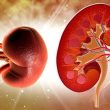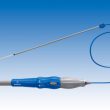No study has been able to prove long-term benefit of regular imaging follow-up after abdominal aortic aneurysm repair by means of endoprosthesis implantation. This is important because the costs for these studies are high, which should be added to potential radiation and contrast morbidity. This work sought to characterize the association between post-endovascular abdominal aortic aneurysm...
Polymer-Free DES Also Show Efficacy in Anticoagulated Patients with High Risk for Bleeding
Patients who receive chronic anticoagulation therapy and then undergo angioplasty are frequently discharged on a triple anti-thrombotic scheme that usually includes aspirin, clopidogrel, and warfarin. The optimal duration of this indication remains unclear, particularly for patients at high bleeding risk. According to expert consensus, patients receiving chronic anticoagulation may receive from 1 to 12 months of dual...
COMPASS: A New Place for Rivaroxaban in Chronic Ischemic Heart Disease
Combining low doses of rivaroxaban and aspirin seems to be the best strategy for patients with stable chronic ischemic heart disease, according to this new study presented at the European Society of Cardiology Congress 2017, which was published simultaneously in the New England Journal of Medicine. Compared with low-dose aspirin alone, the combination of aspirin...
All you need to know about Nicaragua Sessions 2017
For the first time since the Regional Sessions first took place, SOLACI is landing in Managua (Nicaragua) to hold an event of paramount scientific value for Latin American interventional cardiology. The aim of this Sessions is, on one hand, to strengthen SOLACI’s ties with the region and, on the other hand, to promote the specialty’s...
All you need to know about Colombia Sessions 2017
After 3 long years, SOLACI is coming back to Colombia to celebrate the 14th Regional Sessions in an unmissable event to continue to strengthen interventional cardiology in all Latin America. The meeting will take place in Bogota, on October 5 and 6, 2017. Are you planning on participating of the next Colombia Sessions 2017? Here...
“Ad Hoc” PCI during TAVR: No Impact on Safety or Long Term Outcomes
According to a recent study published in Circulation Cardiovascular Interventions, screening for coronary artery disease (CAD) with an invasive coronary angiography (as part of the protocol prior TAVR) and performing PCI and TAVR in the same session, has no impact on periprocedural safety or on long term outcomes. Study outcomes offer new hope, especially as regards using TAVR...
SPYRAL HTN-OFF MED: Renal Denervation Reloaded?
This work presented at the ESC Congress 2017 held in Barcelona, simultaneously published in The Lancet, seems to give hope to all those that still believe in renal denervation. Interim outcomes suggest that a more intensive denervation of renal arteries, carried out at the SYMPLICITY HTN-3 trial, could reduce blood pressure in patients with untreated mild to moderate hypertension....
Positive Outcomes of CoreValve Evolut in Large Population
The Evolut R, as well as its predecessor the CoreValve, is a self-expandable valve, supra-annular, made of porcine pericardium in a nitinol frame. Amongst its improvements, it has a better profile and the option to resheath. This makes it fully repositionable and even recapturable. We only needed to confirm these technical advantages would translate into clinical...
A Simple Electrocardiography to Predict Mortality in TAVR
Conduction abnormalities, such as new left bundle branch block, atrioventricular block, and need for a pacemaker, are still among the most frequent complications in transcatheter aortic valve replacement (TAVR). New valve generations have (mostly) not managed to reduce significantly electrical abnormalities; furthermore, some modifications such as external skirts, which are extremely effective for the reduction...
Post TAVR Dialysis: a Severe Complication Less and Less Frequent
The prevalence of pre-procedural kidney failure in patients undergoing transcatheter aortic valve replacement (TAVR) can be as high as 50 – 60% (stage 3 kidney failure or worse); it has been strongly associated with acute kidney deterioration and, ultimately, an increase of post TAVR mortality. A recent meta-analyzis of several small studies carried out in a single...









